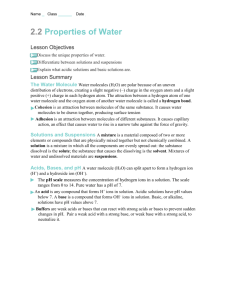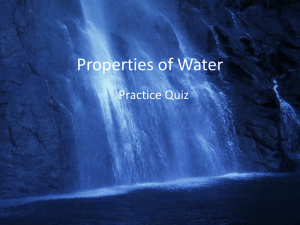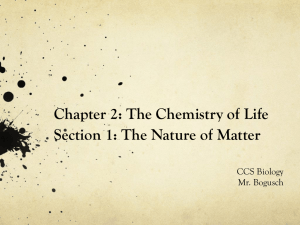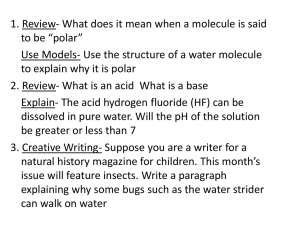Properties of Water From
advertisement
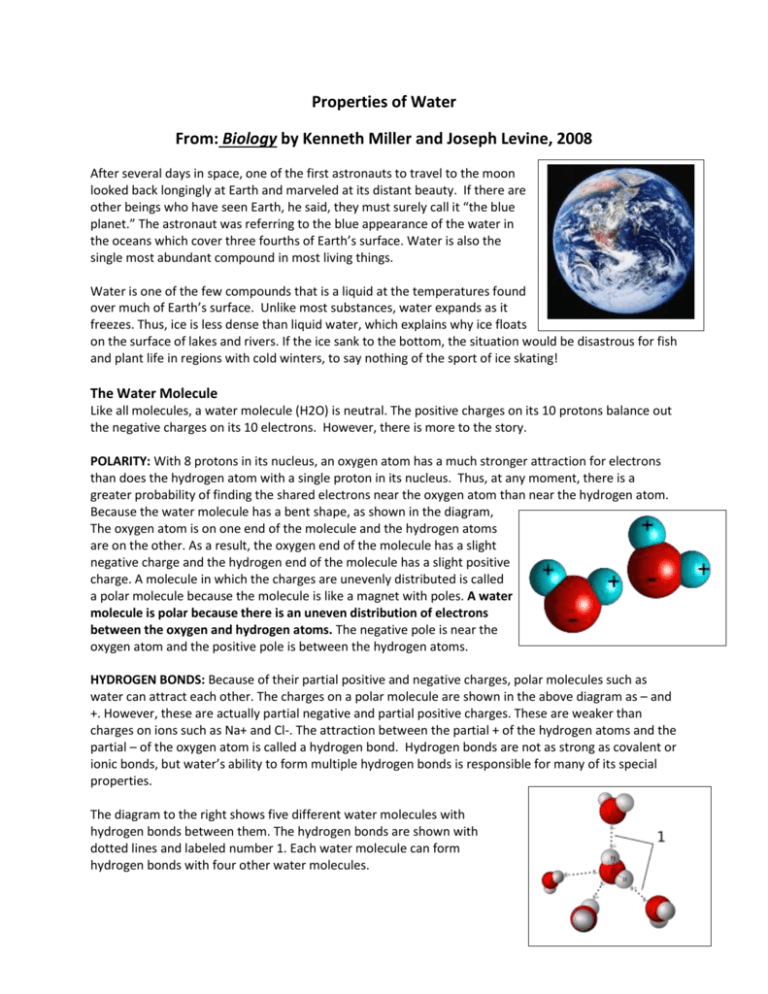
Properties of Water From: Biology by Kenneth Miller and Joseph Levine, 2008 After several days in space, one of the first astronauts to travel to the moon looked back longingly at Earth and marveled at its distant beauty. If there are other beings who have seen Earth, he said, they must surely call it “the blue planet.” The astronaut was referring to the blue appearance of the water in the oceans which cover three fourths of Earth’s surface. Water is also the single most abundant compound in most living things. Water is one of the few compounds that is a liquid at the temperatures found over much of Earth’s surface. Unlike most substances, water expands as it freezes. Thus, ice is less dense than liquid water, which explains why ice floats on the surface of lakes and rivers. If the ice sank to the bottom, the situation would be disastrous for fish and plant life in regions with cold winters, to say nothing of the sport of ice skating! The Water Molecule Like all molecules, a water molecule (H2O) is neutral. The positive charges on its 10 protons balance out the negative charges on its 10 electrons. However, there is more to the story. POLARITY: With 8 protons in its nucleus, an oxygen atom has a much stronger attraction for electrons than does the hydrogen atom with a single proton in its nucleus. Thus, at any moment, there is a greater probability of finding the shared electrons near the oxygen atom than near the hydrogen atom. Because the water molecule has a bent shape, as shown in the diagram, The oxygen atom is on one end of the molecule and the hydrogen atoms are on the other. As a result, the oxygen end of the molecule has a slight negative charge and the hydrogen end of the molecule has a slight positive charge. A molecule in which the charges are unevenly distributed is called a polar molecule because the molecule is like a magnet with poles. A water molecule is polar because there is an uneven distribution of electrons between the oxygen and hydrogen atoms. The negative pole is near the oxygen atom and the positive pole is between the hydrogen atoms. HYDROGEN BONDS: Because of their partial positive and negative charges, polar molecules such as water can attract each other. The charges on a polar molecule are shown in the above diagram as – and +. However, these are actually partial negative and partial positive charges. These are weaker than charges on ions such as Na+ and Cl-. The attraction between the partial + of the hydrogen atoms and the partial – of the oxygen atom is called a hydrogen bond. Hydrogen bonds are not as strong as covalent or ionic bonds, but water’s ability to form multiple hydrogen bonds is responsible for many of its special properties. The diagram to the right shows five different water molecules with hydrogen bonds between them. The hydrogen bonds are shown with dotted lines and labeled number 1. Each water molecule can form hydrogen bonds with four other water molecules. COHESION AND ADHESION: The ability of water to form multiple hydrogen bonds is responsible for many of water’s properties. Cohesion is an attraction between molecules of the same substance. Because of hydrogen bonding, water is extremely cohesive. Water’s cohesion causes molecules on the surface of water to be drawn inward, which is why drops of water form beads on a smooth surface. Cohesion also explains why some insects and spiders can walk on a pond’s surface, such as this water strider: The strong attraction between water molecules produces a force sometimes called “surface tension”, which can support very light objects. Adhesion is an attraction between molecules of different substances. Have you ever been told to read the volume in a graduated cylinder at eye level? The surface of the water in the graduated cylinder dips slightly in the center because the adhesion between water molecules and glass molecules is stronger than the cohesion between water molecules. Adhesion between water and glass also causes water to rise in a narrow tube against the force of gravity. This effect is called capillary action. Capillary action is one of the forces that draws water out of the roots of a plant and up into its stems and leaves. Cohesion holds the column of water together as it rises. Solutions Water is not always pure—it is often found as part of a mixture. A mixture is a material composed of two or more elements or compounds that are physically mixed together but not chemically combined. Salt and pepper stirred together constitute a mixture. So do sugar and sand. Earth’s atmosphere is a mixture of gases. Living things are in part composed of mixtures involving water. SOLUTIONS: If a crystal of table salt is placed in a glass of water, sodium and chloride ions on the surface of the crystal are attracted to the polar water molecules. Ions break away from the crystal and are surrounded by water molecules, as illustrated below. The ions gradually become dispersed in the water, forming a type of mixture called a solution. All the components of a solution are evenly distributed throughout the solution. In a saltwater solution, the salt is the solute—the substance that is dissolved. Water is the solvent—the substance in which the solute dissolves. Water’s polarity gives it the ability to dissolve both ionic compounds and other polar molecules, such as sugar. Without exaggeration, water is the greatest solvent on Earth. Acids, Bases and pH A water molecule can react to form ions. This reaction can be summarized by a chemical reaction in which double arrows are used to show that the reaction can occur in either direction: Water ↔ Hydrogen ion + Hydroxide ion How often does this happen? In pure water, about 1 water molecule in 550 million reacts and forms ions. Because the number of positive hydrogen ions produced is equal to the number of negative hydroxide ions produced, water is neutral. THE pH SCALE: Chemists devised a measurement system called the pH scale to indicate the concentration of H+ ions in solution. As the scale shows, the pH scale ranges from 0 to 14. At a pH of 7, the concentration of H+ ions and OH- ions are equal. Pure water has a pH of 7. Solutions with a pH below 7 are called acidic because they have more H+ ions than OH- ions. The lower the pH, the greater the acidity. Solutions with a pH above 7 are called basic because they have more OH- ions than H+ ions. The higher the pH, the more basic the solution. Each step on the pH scale represents a factor of 10. For example, a liter of a solution with a pH of 4 has 10 times as many H+ ions as a liter of a solution with a pH of 5. ACIDS: Where do all those extra H+ ions in a low pH solution come from? They come from acids. An acid is any compound that forms H+ ions in solution. Acidic solutions contain higher concentrations of H+ ions than pure water and have pH values below 7. Strong acids tend to have pH values that range from 1 to 3. The hydrochloric acid produced by the stomach to help digest food is a strong acid. BASES: A base is a compound that produces hydroxide ions (OH- ions) in solution. Basic, or alkaline, solutions contain lower concentrations of H+ ions than pure water and have pH values above 7. Strong bases, such as lye or bleach, tend to have pH values ranging from 11 to 14. BUFFERS: The pH of the fluids within most cells in the human body must generally be kept between 6.5 and 7.5. If the pH is lower or higher, it will affect the chemical reactions that take place within the cells. Thus, controlling pH is important for maintaining homeostasis. One of the ways that the body controls pH is through dissolved compounds called buffers. Buffers are weak acids or bases that can react with strong acids or bases to prevent sharp, sudden changes in pH.


